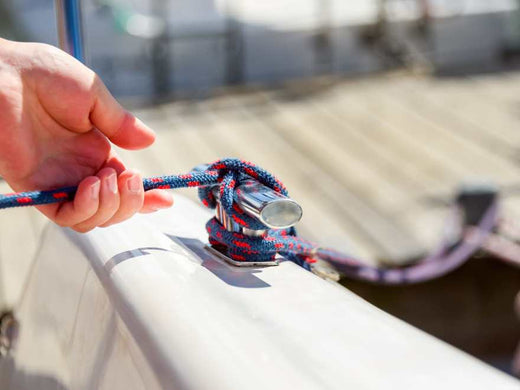
A Guide to Tying Essential Boat Knots
Nicholas HeislerShare
Knowing how to tie the right knots is crucial for any boater, whether you're securing your boat to a dock, tying down equipment, or ensuring sails are properly set. Here's a comprehensive guide to the most common boat knots, how to tie them, and when to use them.
Table of contents:

1. Bowline Knot
When to Use a Bowline Knot:
The bowline knot is one of the most important and versatile knots in boating. It's used to create a fixed loop at the end of a rope, making it perfect for securing lines to a post or ring.
Steps to Tie a Bowline Knot:
- Form a small loop near the end of the rope, leaving enough rope on the working end for the loop size you need.
- Pass the working end of the rope through the loop from underneath.
- Wrap the working end around the standing part of the rope.
- Bring the working end back down through the loop.
- Pull the standing part to tighten the knot.

2. Cleat Hitch
When to Use a Cleat Hitch Knot:
The cleat hitch is the go-to knot for securing a boat to a dock. It's quick to tie and untie, making it ideal for temporary mooring.
Steps to Tie a Cleat Hitch:
- Wrap the rope around the base of the cleat.
- Cross over the top of the cleat, making a figure-eight pattern.
- Wrap the rope under one of the cleat arms.
- Tuck the working end of the rope under the last wrap to secure it.

3. Figure Eight Knot
When to Use a Figure Eight:
The figure eight knot is commonly used as a stopper knot to prevent ropes from slipping out of retaining devices.
Steps to Tie a Figure Eight Knot:
- Make a loop in the rope.
- Pass the working end of the rope under the standing part.
- Bring the working end back over the standing part and through the loop.
- Pull tight to secure the knot.

4. Clove Hitch
When to Use a Clove Hitch Knot:
The clove hitch is used for temporary fastening, such as securing a boat to a pole or post. It's easy to adjust and untie, making it suitable for quick mooring.
Steps to Tie a Clove Hitch:
- Wrap the rope around the object.
- Cross the working end over the standing part to make an X.
- Wrap the working end around the object again.
- Tuck the working end under the last wrap and pull tight.

5. Sheet Bend
When to Use the Sheet Bend Knot:
The sheet bend is ideal for joining two ropes of different thicknesses. It's useful when you need to extend a line or secure an extra rope.
Steps to Tie a Sheet Bend:
- Form a bight (U-shape) in the thicker rope.
- Pass the working end of the thinner rope through the bight from underneath.
- Wrap the working end around both parts of the bight.
- Tuck the working end under itself.
- Pull both standing parts to tighten the knot.

6. Reef Knot (Square Knot)
When to Use the Reef Knot:
The reef knot is used for securing non-critical items such as sails or bundles of equipment. It's easy to tie and untie, making it practical for simple tasks.
Steps to Tie a Reef Knot:
- Cross the right end over the left end.
- Loop the right end under the left end.
- Cross the left end over the right end.
- Loop the left end under the right end and pull tight.
Hit the Water With Confidence in Your Knot Knowledge
Mastering these essential knots will enhance your boating experience by ensuring safety and efficiency. Practice these knots regularly so they become second nature, and always double-check your work to ensure security. With these skills in hand, you'll be better prepared to handle any situation that arises while out on the water. Happy boating!
When it comes to keeping your boat clean, look to Captains Preferred Products boat cleaning supplies. Find everything you need to keep your vessel squeaky clean all season - always at the best prices.




